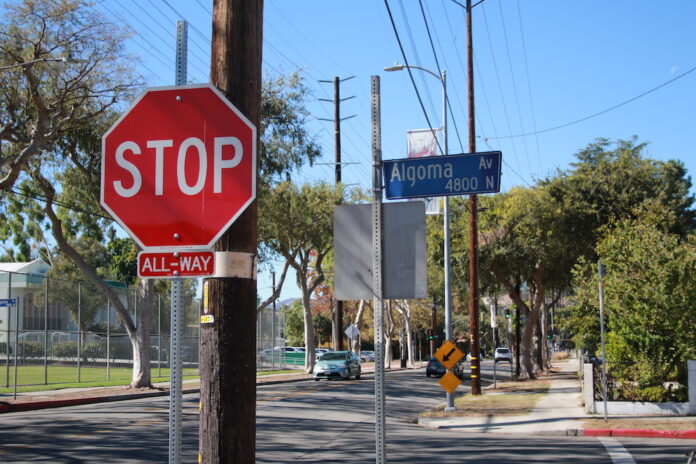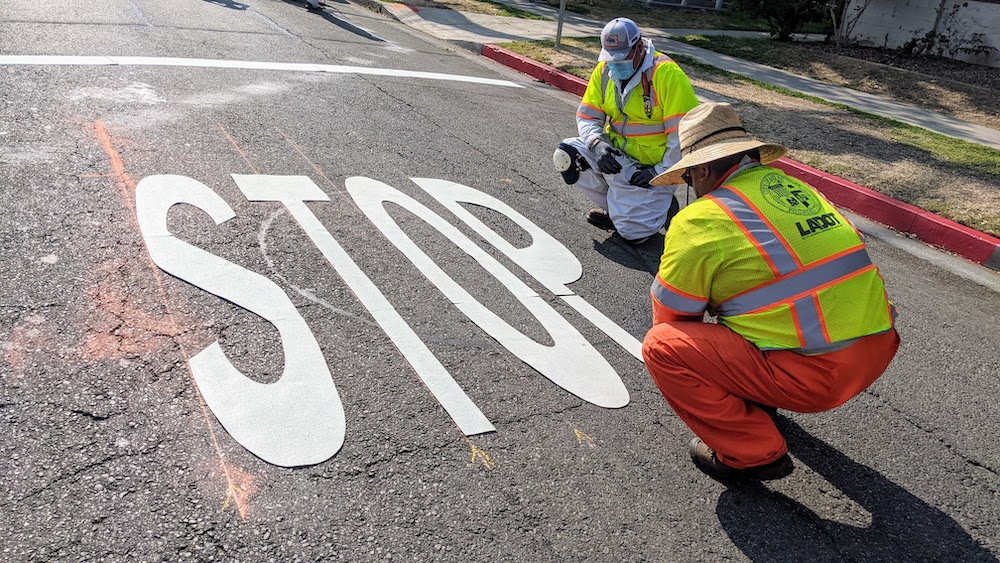
The Eagle Rock Association (TERA) launched the Slow Yosemite initiative in 2019 in response to the high volume of traffic crashes on Yosemite Drive, according to Michael MacDonald, treasurer for TERA and an advocate for Slow Yosemite. Since its launch, the initiative has advocated for changes including additional stop signs, bike lanes and raised crosswalks, according to MacDonald.
The stretch of Yosemite between La Roda Avenue and Algoma Avenue is on LA’s High Injury Network (HIN), which tracks streets with a high concentration of traffic accidents that result in severe injuries and deaths, especially involving pedestrians and cyclists, according to the HIN website. According to analysis from the Los Angeles Department of Transportation (LADOT), streets in the HIN represent only 6 percent of LA’s total street mileage, but account for 65 percent of all deaths and severe injuries involving pedestrians.
MacDonald said two Eagle Rock High School (ERHS) students were injured in a car crash on Yosemite in October 2017, when a driver failed to yield to them at a crosswalk on Vincent Avenue. A similar incident occurred in May 2015, when a mother and her two children were hospitalized after being hit by a vehicle at a crosswalk on Yosemite, MacDonald said.
The initiative successfully advocated for the city of LA to install five stop signs on Yosemite this year as Phase One of the project, according to MacDonald. These new stop signs are on Rosemary Drive, Norwalk Avenue, Algoma Avenue, Vincent Avenue and Glacier Drive. LA also installed a stop sign on Floristan Avenue in March 2020.
According to MacDonald, the initiative’s steering committee includes principals at ERHS and Rockdale Elementary, the ERHS Parent, Teacher & Student Association (PTSA), the PTAs of Rockdale, Eagle Rock and Dahlia Heights Elementary and ROCK Coffee House. According to the Slow Yosemite website, the initiative has partnered with Councilmember Kevin de León for the project. The Eagle Rock Neighborhood Council (ERNC) has also worked with the initiative and helped fund a consultant to design the proposed roadway changes, according to Richard Loew, president of the ERNC.
Titus Campos, community of schools administrator for the Eagle Rock/Highland Park Community of Schools in Los Angeles Unified School District (LAUSD), said he wrote a letter of endorsement for the initiative in October 2021.
“I decided to endorse this initiative because, in the past, we have had students hit by vehicles,” Campos said. “I’d rather be proactive than reactive and make sure that our students are safe.”
The initiative affects students in particular because ERHS, Rockdale Elementary and the Yosemite Recreation Center are on Yosemite, MacDonald said. Yosemite is also frequented by students from nearby schools like Eagle Rock Elementary and Dahlia Heights Elementary, according to MacDonald.
“Yosemite Drive is the heartbeat of our school community,” MacDonald said. “It’s like a central connector for families in Eagle Rock. And it’s really a problem that it has transformed into a street that has made people feel uncomfortable and has made people unsafe.”
According to Colin Sweeney, public information director for LADOT, proposed roadway changes must go through a community engagement process in which people can voice their experiences and concerns. MacDonald said outreach took place on Zoom, through open house events and meetings with school PTSAs.
TERA worked with LADOT and the city council to ensure there was sufficient support for Slow Yosemite, Sweeney said.
According to David Greene, treasurer of the ERHS PTSA, TERA has frequently visited the PTSA to provide updates about the project’s progress and receive community feedback. The feedback about the stop signs has been positive, according to Greene.
“The mark of a good public improvement like this is that it appears that it has been there all along, meaning people got used to it very quickly,” Greene said. “All the stop signs, certainly around the high school, and the regulating of the traffic, seemed a natural fit.”

Stephen Kia, president and CEO of ROCK Coffee House and parent at Eagle Rock Elementary School, said the project is bringing walkability to the neighborhood, which benefits local businesses. Kia said ROCK Coffee House, which is a part of the nonprofit Reach Our Community Kids, is one of the primary sources of funding for the organization.
“We really rely upon foot traffic to help us do what we do,” Kia said.
Rocío Rivas, a PTA member at Rockdale Elementary, said the parents’ reaction to the stop signs has largely been relief.
“You feel a little bit at ease, knowing that there are safety measures in place,” Rivas said.
According to Loew, community members have raised concerns at ERNC meetings about these changes potentially causing traffic.
“The concerns of the community that have been expressed in some meetings have been [about] the ability to use Yosemite in a way that doesn’t delay their travels,” Loew said.
Sweeney said the initiative did not propose removing lanes of traffic, an idea which had caused lengthy engagement processes for other projects because of concerns about increased travel time. Instead, according to Sweeney, there was no community resistance to Slow Yosemite, and residents and community members saw a need for improvements.
“When we have a strong engagement process, what you see is that the folks who are most impacted — as in the ones who live in an area as opposed to those who might drive through from time to time — usually want those safety improvements if a street has a history of collisions,” Sweeney said.
For Phase Two of the project, according to Sweeney, the city will add additional bicycle lanes on Yosemite after resurfacing the street, which is scheduled to be done by the end of the current fiscal year or July 2022 at latest.
Rivas said she hopes this initiative will spark change in other neighborhoods as well.
“Hopefully this will at least ignite something within our city, society or culture,” Rivas said. “We need to be safe with our bicyclists and our pedestrians and that means that we just have to slow down.”
This article was revised Nov. 3 at 12:16 p.m. to reflect that Stephen Kia is a parent at Eagle Rock Elementary School, not Rockdale Elementary School. It was revised again Nov. 3 at 6:00 p.m. to reflect the stretch of Yosemite that is included in the HIN.
![]()


































